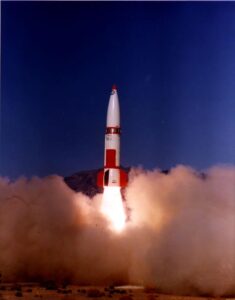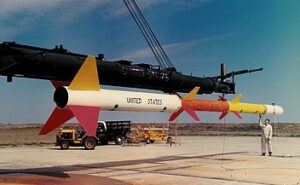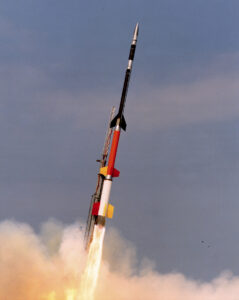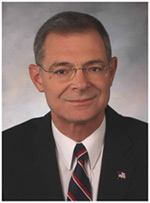Basic Rocket Science
 The Basic Rocket Science (BRS) short course provides a practitioner-based training experience in the key principles, disciplines, technologies, and how-to protocols of suborbital rocket flight.
The Basic Rocket Science (BRS) short course provides a practitioner-based training experience in the key principles, disciplines, technologies, and how-to protocols of suborbital rocket flight.
Participants learn about the various phases of rocket flight including launch, boost, coast, and recovery. The workings of the atmosphere and its influences on endoatmospheric rocket flight performance are examined. The principles of solid rocket propulsion are presented, and representative solid rocket motor propulsion characteristics reviewed.
Trajectory simulation based on the round Earth equations of motion is a significant topic of instruction. Key rocket vehicle aerodynamics data such as zero-lift drag characteristics and aerodynamic force and moment derivatives are
examined as are methods for computing these parameters. Vehicle mass properties such as weight, center-of-gravity, and moments of inertia are discussed as well as methods for computing these quantities.
 Course members also receive instruction on the static and dynamic stability requirements for each stage of a rocket-powered vehicle. Aerodynamic heating effects and methodologies are presented from the standpoints of vehicle thermal design, analysis, and survivability. Parachute recovery of rocket components is discussed as is the generation of debris dispersion footprints sometimes required for range safety clearance.
Course members also receive instruction on the static and dynamic stability requirements for each stage of a rocket-powered vehicle. Aerodynamic heating effects and methodologies are presented from the standpoints of vehicle thermal design, analysis, and survivability. Parachute recovery of rocket components is discussed as is the generation of debris dispersion footprints sometimes required for range safety clearance.
- Atmospheric Properties
- Solid Rocket Motor Propulsion
- Single Stage
- Multiple Stage
- Static Stability
- Dynamic Stability
- Aerodynamic Heating
- Mass Properties
- Stabilizing Fins
- Tangent Ogive
- Zero-Lift Drag Characteristics
- Aerodynamic Derivatives
- Launch Lugs
- Altimeters
- Trajectories
- Equations of Motion
- Atmospheric Models
- Parachutes
- Dispersion Footprints
- FAA Clearance
- Flight Simulation
- Range Safety
- Data Uncertainties
- Aero Prediction
- Onboard Video
 Basic Rocket Science (BRS) is a top-level treatment of the principles, disciplines, technologies, and how-to protocols pertinent to designing, analyzing, and flying single stage and multi-stage rocket-powered vehicles. The knowledge provided is applicable to rocket flight at any scale including model rocketry, high-power rocketry, experimental rocketry, and commercial rocketry.
Basic Rocket Science (BRS) is a top-level treatment of the principles, disciplines, technologies, and how-to protocols pertinent to designing, analyzing, and flying single stage and multi-stage rocket-powered vehicles. The knowledge provided is applicable to rocket flight at any scale including model rocketry, high-power rocketry, experimental rocketry, and commercial rocketry.
Basic Rocket Science Module Overview
- Rocket Vehicle Flight Operations: Launch, Boost, Coast, and Recovery, range facilities and flight support personnel, altimeters, record keeping, photo and video support.
- Earth’s Atmosphere: Atmospheric pressure, density, temperature, wind, variations with altitude, atmospheric models.
- Airframe Design: Single and multiple stage configurations, static and dynamic stability considerations, nose external shapes, stabilizing fin geometries and sizing.
- Trajectories: Round earth equations of motion, rocket vehicle flight simulation, single and multiple stage flight performance.
- Propulsion: Solid rocket motor operation, total impulse categories, thrust-time curve data, specific impulse, data uncertainties.
- Aerodynamics: Aerodynamic zero-lift drag characteristics, aerodynamic force and moment derivatives, data uncertainties.
- Mass Properties: Stage weight, center-of-gravity, and moment of inertia characteristics, data uncertainties.
- Aerodynamic Heating: Causes of aerodynamic heating, vehicle stagnation point and acreage heating estimation, maximum surface temperature and airframe thermal design.
- Debris Dispersion Footprints: Impact/landing dispersion estimation, range safety, flight clearance and altitude limitations, effects of winds, thrust misalignments, and vehicle imperfections.
This course is best suited for individuals who want to learn how to successfully design, analyze, launch, and recover rocket-powered vehicles of any scale including model rockets, high-power rockets, experimental rockets, and commercial rockets.
General Requirements
- Algebra
- 1st Year College Calculus
- 2nd Year College Calculus
- 1st Year College Physics
Suggested WEA Preparatory Courses

J. Terry White terry@whiteeagleaerospace.com Curriculum Vitae
J. Terry White is the founder, senior advisor and former president of White Eagle Aerospace. His 50 years of professional aerospace experience includes the NASA Space Shuttle Program, NASA X-43A Flight Research Project, and the United States Navy STANDARD Missile Program. During his far-ranging professional career, Terry has served on the engineering technical staff of Rockwell International, General Dynamics Corporation, Hughes Missile Systems Company, NASA Dryden Flight Research Center and Raytheon Missile Systems. In addition, he has served as an engineering consultant to numerous corporate and private aerospace enterprises.
Terry is a subject matter technical expert in the disciplines of aerodynamics, 6-DOF aerodynamics models, aerothermodynamics, hypersonics, flight simulation, and flight testing.
Terry previously served as manager of the Aerodynamics Department in the Guidance, Navigation, and Control Center at Raytheon Missile Systems in Tucson, Arizona. In this capacity, he was responsible for all aerodynamics work performed at the world’s largest tactical missile producer. He concluded his career with Raytheon in 2010 as a Senior Engineering Fellow in Aerodynamics.
Terry has authored more than 180 technical papers on a wide variety of aero-science and aerospace subjects. His teaching credentials include 15 years as an instructor in the Aerospace Engineering Department of the California State Polytechnic University, Pomona, 10 years as an instructor in the professional development program at Raytheon and 17 years developing and teaching technical courses at White Eagle Aerospace. Those who have taken Terry’s courses say that he brings an extensive technical knowledge and uncommon instructional skill to the training environment.
Terry is particularly well-known for his inspiring aerospace history presentations, which are intense, technically relevant reviews of significant events in United States aerospace history. He has lectured extensively on aerospace history topics at the USAF Test Pilot School, the Society of Experimental Test Pilots, the National Aeronautics and Space Administration, the American Institute of Aeronautics and Astronautics, academia and industry.
Terry and his wife Phyllis reside in Oro Valley, Arizona. They are the happy parents of five remarkable children and the grateful grandparents of nine delightful grandchildren.
We provide on-site short courses for businesses and government organizations. Individuals who wish to attend a course should contact us here.

